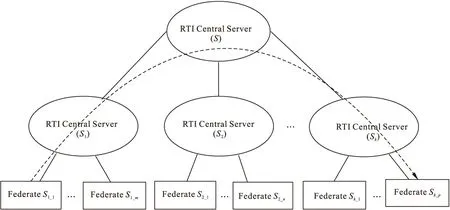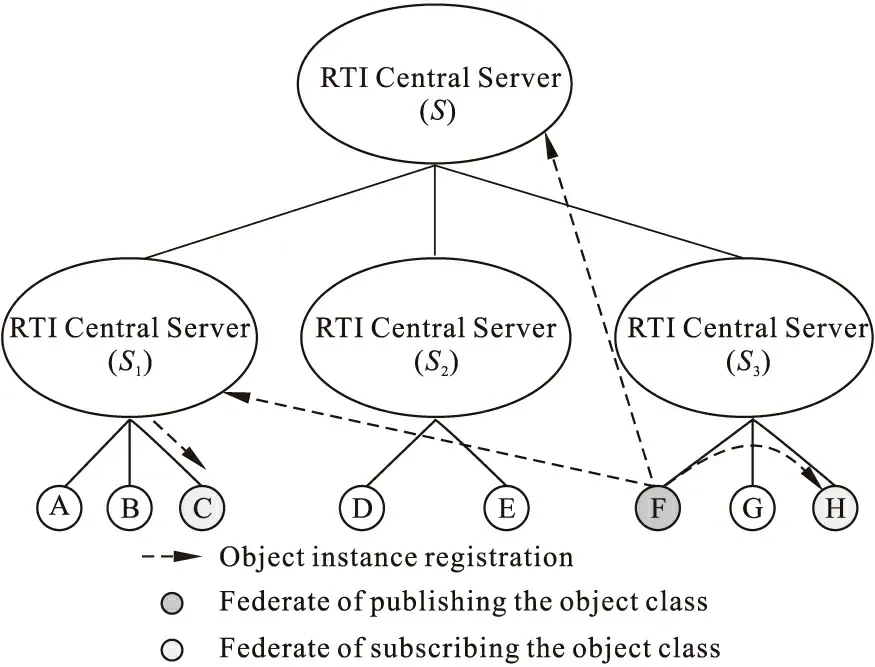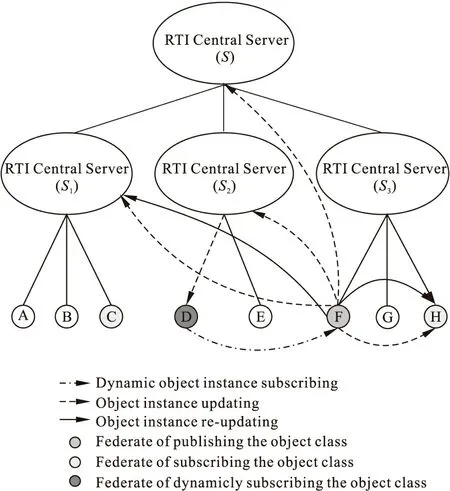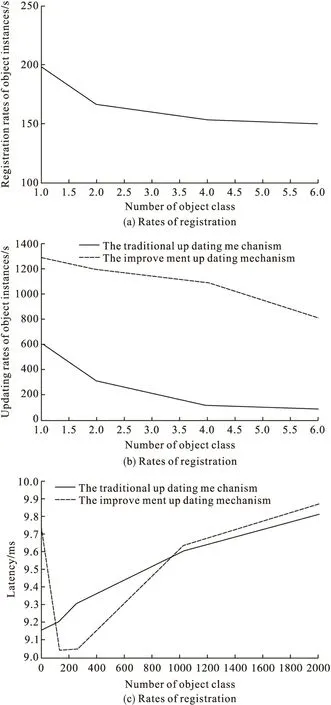Improvement of Update Mechanism for Object Management in High Level Architecture
2014-09-14FENGYongxinFEIShunchaoTIANMinghaoQIANBo
FENG Yongxin,FEI Shunchao,TIAN Minghao,QIAN Bo
(Shenyang Ligong University,Shenyang 110159,China)
In order to create the common reusable infrastructure for distributed simulation,a standardized High Level Architecture (HLA) has been developed[1-4].As the open,object oriented simulation architecture,compared with the other architecture;HLA has more interoperability and interactivity between simulations,can aid the reuse of models in different contexts.Specially,with the core component supporting,HLA can define the standard services that simulations utilize for coordination and collaboration,that is,the common Runtime Infrastructure (RTI)[5].The RTI provides six category services,among of them,object management is the base service for both HLA and simulation operation.However,the object instance update mechanisms of object management should be improved to satisfy the dynamic federation subscribing and object class information coordination.
Therefore,we focus on the research of update mechanism improvement for object management in this paper.The work of the paper is organized as follows.Section 1 briefly presents the High Level Architecture and Runtime Infrastructure,emphasizing on the hierarchical RTI.Section 2 introduces the object management in HLA,including the object registration,update,delete and so on.Section 3 focuses on update mechanism improvement and its process.Moreover,simulation and analysis has been described.Finally,our conclusions are presented.
1 THE HIGH LEVEL ARCHITECTURE AND RUNTIME INFRASTRUCTURE
As the distributed interactive simulation technology,HLA can supply the integrated simulation environment with the coordinative structure,standard,protocol and database,on which the simulation terminals or programs are connected with the local or wide networks,so as to be the more interoperate simulation platform.HLA has defined the key principles and interface specifications from the aspects of system design and implementation during the simulation process,including the HLA rules,HLA interface specification,HLA object model template (OMT).In HLA rules,the federation and federate rules are described as well.Moreover,the interface specification in HLA is including the six categories,(1) federation management,(2) declaration management,(3) object management,(4) ownership management,(5) time management,and (6) data distribution management.Besides,the federation object model and simulation object model are defined in OMT respectively.
While HLA is the architecture and not software based,its core instrument in supporting the runtime services is the RTI software,which is the core component for federation operation.Specifically,as the RTI is intended to support a broad range of simulation communities,several federation types including test and evaluation,training,mission rehearsal and analysis should be considered.Within these communities,the RTI must accommodate varying host hardware and programming languages and allow for variegated levels of accuracy,scale,levels of resolution,communications latency,throughput and synchronization.Therefore,the RTI software architecture can be divided into 3 models,the centralized RTI,distributed RTI and hierarchical RTI[6-7].
The centralized RTI is configured with the single server,which manages the ownership information of all objects′ attributes in the virtual environment.When an ownership transfer starts,one federate will send the ownership querying or acquiring request to the RTI,and this RTI coordinates the transfer process.This approach is simple and easy to maintain the consistency of ownership,but the RTI is the system bottleneck which limits the efficiency of the ownership management in large-scale applications or frequent transfer scenarios.The distributed RTI is configured with many servers,called multi-server RTI.A collaborative ownership management may be required among several RTI servers,and then the consistency of the distributed ownership information will be a problem.In order to improve the performance bottleneck of centralized RTI,solve the load balance,time and space consistency,interoperability among distributed RTI,the hierarchical RTI has been studied and implemented,shown in Fig.1.The central server and the local server are denoted byS,S1,S2,…,Skwith a subscript to distinguish different servers,while the simulation federates in virtual environment are denoted by FederateS1_1,S1_2,…,Sk_pwith different subscripts to indicate different simulation federates.Every federate must be managed by a server,and every server can manage multiple simulation federates.In hierarchical RTI,the servers are configured with different levels and duties,as the central server,many local servers.The central server is in charge of the local servers to keep the balance and consistency,while the local servers are duty on the local operation and management.
2 OBJECT MANAGEMENT IN THE HLA
In fact,the object management in HLA[8-10]deals with the registration,modification,and deletion of object instances and the sending and receipt of interactions.All the information in simulation application based on HLA has been usually defined as events,including the object instances and interactions.Contrast to the interaction instances,the object instances can represent the permanent messages from registration until deletion,the efficiency of which connects with the data distribution management and time management.

Figure 1 Hierarchical RTI software architecture
In the hierarchical RTI,the registration procedure of object instances is shown in Fig.2.In general,the registration messages of object instance from the special federate should be passed to the central RTI server,the federate subscribing the same object class.In Fig.2,as the object class owner,federate F will pass the object instance messages to the RTI server,federate H managed by the same local server,federate C managed by other RTI server,subscribing the object class as well.

Figure 2 Hierarchical RTI software architecture
During the federation simulation operation,if the attributes of some object instance has been changed,the federate should be on duty to update the attribute values so that update messages can be passed to the federates,which has ever subscribed the object class.The process of updating the current values for the instance attributes specified by the federate that owns it is called updating attribute values.The RTI will now distribute new instance attribute values to subscribing federates.Fig.3 has shown the process,that is,federate F must do the process of updating attribute values,while federate C and H will receive the updating messages.

Figure 3 Updating Object instance operation
In simulation environment,if the federate wants to be exit or a specified object instance should be removed from the federation execution,then the procedure called deleting object instance happens,by which the RTI can use removing object instance to inform the reflecting federates that the object is no longer available.Fig.4 has shown how the object instance can be deleted,in the operation,federate F owning the special object instance should send the message of deleting object instance to the RTI central server and every local server.Then,the server will send the messages of removing object instance to inform the federate so as to the object instance has been deleted from the federation execution.

Figure 4 Deleting object instance operation
3 IMPROVEMENT OF UPDATE MECHANISM
In fact,the traditional object instance update mechanism can′t supply the dynamic object subscription to the simulation operation.The relationship between the federate subscribing and publishing is initially configured,and the exchange is very limit.That is,if some federate wants to acquire the special object attribute values during the simulation instead of the initial subscription,only through the RTI server which had ever registered the object instances.However,the object attribute values supplied by RTI server may be not consistent and synchronous with the object instance published by the original federate in the traditional update mechanism,because of the update operation with pre-configuration.In Fig.3,if federate D needs to subscribe the object instance published by federate F during the simulation operation dynamically,instead of the initial configuration,the wrong attribute values of the object instance can be queried from the RTI central server,because of the process of updating triggered by federate F uncovering the RTI central server,so that the non-consistency happens,represented by the different object instance attribute values among federate F,C,H and D.
According to the consistency and synchronization during the simulation operation,as well as the coordination of object instance attribute update process,especially the correct and unique attribute value modification,the improvement of update mechanism has been proposed,the process of which has been shown in Fig.5.
Step 1,on the initial simulation configuration phase in the hierarchical RTI,federates do the object class subscription through the special RTI serverS1∈{S,S1,S2,…,Sk},that is,Sas the central server,S1,…,Skas the local server respectively.
In Fig.5,the simulation federates are defined as A,B,C,D,E,F,G and H,which are managed by four servers in the hierarchical RTI,andSas the central server,S1,S2andS3as the local servers.During the simulation initial configuration,the object class subscribing of federates was implemented.
Step 2,as the object class owner,federateSi_jbelongs to the special RTI local serverSiand the identifier of the managed federates in the region of simulation as thej,which will receive the object class subscribing messages from other federates.
In Fig.5,F as the federateSi_j,also the federateS3_1,that is,managed by the local serverS3and the order identifier as 1.Besides,G and H managed by the local serverS3,as the federateS3_2andS3_3.As the same,the other federates are defined.In Step 2,F received the subscribed object class messages from federate C and H.
Step 3,federateSi_jbegins to send the object instance messages to the object class subscribing federates in the simulation federation,specially through the RTI central server,the local servers as the manager of the subscribing federates.
In Fig.5,federate F should send the object instance messages to C through the RTI local severS1,and directly to H belonging to the same local server.
Step 4,in the simulation operation,when the attribute values of the object instance have been changed,federateSi_jdoes the update operation,and sends the attribute updating messages to the federates which have ever subscribed on the initial configuration.
In Fig.5,federate F asSi_j,should operate the update mechanism with sending the updating messages to RTI central serverSand local serverS1in order to implement the updating attribute values of object instance of federate C,H.
Step 5,as the dynamic subscribing federate in the simulation,federateSs_fwill send the message toSi_j,once the subscribing message being accepted,federateSi_jdoes the query operation so as to make the decision whether federateSs_fbelongs to the initial configuration or not.
In Fig.5,federate D asSs_fneed couple with F asSi_jby sharing with the simulation information or data according to the simulation background or event trigger,while not do the object class subscription on the initial simulation configuration phase.Therefore,federate D should begin to do the dynamic object subscription with sending the subscribing message to F,which can inspire the object instance updating.During the process,once the subscribing message accepted by F,the query operation should be implemented with searching the initial configuration tables stored in F.
Step 6,if the querying results have shown thatSs_fis the new dynamic subscribing federate,then federateSi_jdoes the new update operation,that is,sends the updating messages to relative RTI servers in the hierarch RTI so as to keep the consistence and synchronization.

Figure 5 Improvement of updating
In Fig.5,according to the query operation,federate D could be confirmed as the dynamic subscription,so federate F should send the updating messages to each RTI servers managing the federates,which had ever subscribed.With the process,the dynamic or initial subscribing federates could acquire the current values or states for the instance attributes specified by the federate during the dynamic simulation.Therefore,the consistence and synchronization could be achieved.
4 SIMULATION AND ANALYSIS
On the basis of the improvement of updating,the satellite navigation simulation has been done with the improvement of update mechanism to operate the object class management.During the simulation,besides the central server,3 local servers have been configured to manage the RTI federates to be defined as the satellite signal federates,receiver federates,interference and the application platform federates.The interference federate operates the dynamic subscribing object instance to the receiver,which is managed by the different RTI local server.Fig.6a showed the initial registration rates of object instances,considering the special simulation environment,which represented the trend of registration rates with the object class adding.The rates of registration procedure can be achieved at 150 object instances per second.

Figure 6 Efficiency results of simulation
The updating rates of the improvement updating mechanism has been shown in Fig.6b,compared with the traditional updating so as to improve the efficiency in the simulation according to the dynamic subscribing and the attribute consistence.In Fig.6c,the latency of updating has been shown,in which,the time cost of updating has been shorten in some small numbers of object instances,while the latency of improvement updating mechanism may be more with the object instance adding.However,the latency of updating can′t be avoided due to keeping the unique updating consistence.As well,RTI can′t be adapted with the blob data transfer in the real-time simulation system.In the satellite navigation simulation,the average updating values is 396 bytes of each step simulation so as to the latency of updating less than 0.9ms.
5 CONCLUTION
According to the traditional updating mechanism of object management in the hierarchical RTI,the improvement of updating has been proposed,especially considering the dynamic object instance subscribing or attribute value updating.The simulation results showed that the improvement mechanism can achieve the better updating rates and the latency than the traditional updating mechanism.Specially,the consistence can be achieved as well,during the dynamic federate subscribing in the object management.With the development of the distributed interactive simulation technology,it is necessary to improve the efficiency,flexibility and scalability in the object management.
[1]High Level Architecture (HLA)-Interface Specification,Version1.3[R].New York,USA:Defense Modeling and Simulation Office,1998.
[2]IEEE Std 1516-2010 (Revision of IEEE Std 1516-2000),IEEE Standard for Modeling and Simulation (M&S) High Level Architecture (HLA)-Framework and Rules[S].2010.
[3]IEEE Std 1516-2010 (Revision of IEEE Std 1516-2000),IEEE Standard for Modeling and Simulation (M&S) High Level Architecture (HLA)-Federate Interface Specification[S].2010.
[4]IEEE Std 1516-2010 (Revision of IEEE Std 1516-2000),IEEE Standard for Modeling and Simulation (M&S) High Level Architecture (HLA)-Object Model Template (OMT) Specification[S].2010.
[5]Zhou Zhong,Xu Cheng,Hou Wen,et al.Distributed Ownership Management Algorithm for HLA/RTI Implementation[J].Journal of Computational Information Systems,2011,7(5):1628-1637.
[6]Jung Hyun Ahn,Tag Gon Kim.Design and implementation of hierarchical RTI (HRTI)[C].Proceedings of the 2009 SISO European Simulation Interoperability Workshop, 2009:111-121.
[7]Gao Peng,Jin Chun,Wang Gang.HLA-based distributed simulation model for multimodal operation system on container terminals[C].7th International Conference on System Simulation and Scientific Computing,2008:411-416.
[8]Chen Ying-min.Based on HLA and C + + language the federal members of the prototype class design and implementation[J].Micro-computer Information,2011,27(10):150-152,101.
[9]Me Hong-biao,Wang Jian,Zhang Hui-zhe.Research on deadlock in HLA time management[J].Journal of System Simulation,2011,23(5):935-940.
[10]Feng Yong-xin,Zhu Wei.Research on short wave frequency-hopping simulation system based on HLA/ RTI[J].Fire Control & Command Control,2011,36(4):40-42,49.
